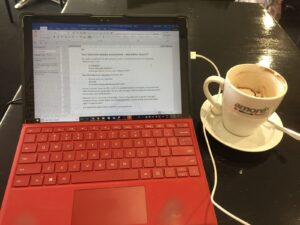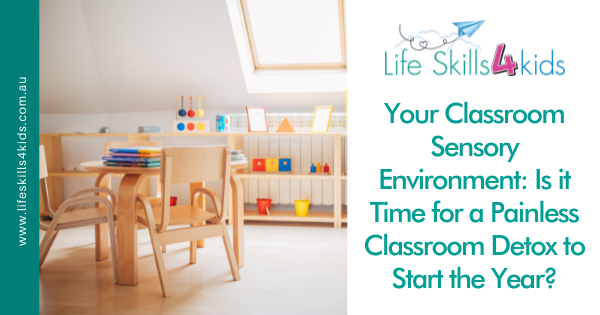Your classroom sensory environment – why bother about it?
Okay, before we get into the nitty gritty, let’s take a minute to think about our favourite relaxation place. Is it
- On the beach?
- At your favourite restaurant?
- Curled up in bed or on the couch reading a book?
What sensory environment is perfect for work and concentration for you?
Now, think about your favourite work space. Is it
- At work or in your classroom?
- At home?
- Is it quiet or do you like background noise?
For me, my office nook at home is a converted room in the roof cavity. It has a low roof, a little window and a cute sky light. It’s very cute and cosy. I love to create and sneak away from the world to work, think and plan.

However, when it comes to writing blogs, I have my favourite café. It has the “just right” ambience for me. A little chatter and background music, a corner to hide in but with bright lights to keep me alert.
I’ve tried all the cafes in town, but this is my favourite one. I’m sitting here right now writing this, as I’m almost guaranteed inspiration just by making the effort to drive into town and order a cuppa.
The “Just Right” Sensory Environment for working is different for everyone
If we did a survey of your colleagues, I’m sure that we would discover some very unique and different ways that we prefer our sensory environment for work and relaxation.
It’s the same in classrooms. Every teacher has a different way of expressing their individuality, and as a part of this, we are all different in our mix or patterns of sensory processing. If you are a professional working in a clinic, the same applies for you.
Some prefer pastel and calm colours. Other prefer bold and bright primary colours. Colour is a very powerful medium that can make us feel calm, alert, active, or even hungry.
Creating the perfect sensory environment for learning in classrooms
The Clever Classrooms Project has researched many aspects of the sensory classroom learning environment and is a great resource for discovering how to action change in the classroom.
However, knowing exactly how to assess and make changes in your classroom can be very daunting to start with, and you still can be unsure of what to do.
So, we put together a program where you can find all the information you need to improve your own classroom sensory environment in one place.
The 20-Day Classroom Detox is an accredited program for teachers (in NSW) which steps teachers through what to look for when taking a fresh look at their classroom sensory environment. It is also useful for other professionals such as Occupational Therapists who assist teachers. Each day of the program (or step) addresses one aspect of your classroom. You can do one a day for 4 weeks, or you could even do one step (half an hour) each week. Initially, we give you access to the program for 6 months, but you can always extend if life gets complex.
The 20-day Classroom Detox program explains the impact of the different sensory areas on learning, such as:
1. the visual environment, glare, how to colour block and group items together etc.
2. auditory processing,
3. assessing the playground on how it meets sensory needs
4. alternative seating for increasing concentration
5. using muscle and movement in class to keep kids on track and concentrating.
The effects of all these factors on a child’s learning experience cannot be underestimated. Just as you have your own preferred work space environment, so does a child. Even small adjustments that improve the classroom environment can have a massive effect, especially when you consider that you and your students spend almost a quarter of your day in the classroom. The 20-Day Classroom Detox program helps you make those adjustments, one step at a time.
More resources for improving your classroom sensory environment
Because I’m passionate about improving the learning experience for all students, I’ve also created the School Environment Sensory Checklist, a short eBook that not only explains why it’s important to re-examine our schools and classrooms, but also provides practical tips, ideas and strategies that you can implement in your classroom for real results.
I believe that understanding the reasons behind disruptive behaviour and lack of engagement is the first step to changing it. And those reasons can be very surprising. But once you understand where they’re coming from, you’re going to be better equipped to make adjustments that make classroom life easier for everyone – yourself included!
At the end of the School Environment Sensory Checklist, you’ll find a helpful printable worksheet that will guide you step-by-step through creating your own sensory-safe classroom environment.
New school year – new classroom sensory environment
So why not take the opportunity that a new school year brings to take a good hard look at what’s really going on in your classroom and identify ways to make the learning environment into one that benefits you AND your students?
Creating the best classroom sensory environment you can will make the world of difference to the ways your students cope with classroom distractions and increase their ability to concentrate and engage with the learning process.
You already know from your own experience how the space around you when you work increases both your inspiration and productivity. Putting even small strategies in place, such as those you’ll find in the helpful resources on our website, will do the same for your students.
Come and join me in my mission to help all children overcome sensory and emotional issues and empower their families to deal with the stresses of their day-to-day lives.

